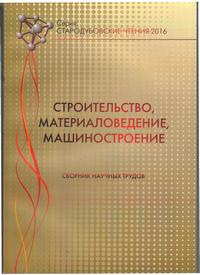Modification the weld metal structure of hsla steels by refractory nanoparticles
Keywords:
arc welding, the weld metal ingot, nanopowder inoculators, decomposition of austenite, microstructur.Abstract
Purpose. The aim of study was to investigate the impact of nano-dispersed particles of refractory metals in the molten metal of the weld pool and the crystallization kinetics of austenite in the metal joints of high-strength low-alloy steels. The results of studies of the metal structure of high-strength low-alloy steel joints 14HGNDTS, which were introduced into the melt. Nanopowder particles of various refractory compounds - oxides, nitrides and carbides (TiC, TiN, SiC, VC, NbC, TiO2, Al2O3, MgO, ZrO2). The studies showed the effectiveness of nanooxides TiO2 titanium and zirconium ZrO2, thus ensuring high values of the mechanical properties of the weld metal (Rm -708 MPa and 621MPa, KCV-20 - 60 J / cm2 and 72.9 J / cm 2, δ - 21 and 19%), due to the formation of the complex and needle bainitic structures. Using Gleeble 3800 installation simulating thermal cycles it possible to establish the relationship between the temperature conversion interval, the number of structural components and the type of modifying nanoparticles. Originality. Modification of metal nanoparticles seams titanium and zirconium oxide ZrO2 TiO2 leads to the development of transformation at high temperatures to form bainite acicular ferrite, which complex has a favorable strength, plastic and viscous properties. Carbides TiC, SiC and nitrides of TiN, NbN lowering the bainite start temperature lead to the formation of bainitic-martensitic structures (lower bainite, microphase MAK-phase), which have reduced viscous and plastic properties. Compounds of VN, VC and ZrC are readily soluble in the molten metal of the weld pool and therefore, they are of little use as effective metal structure modifiers seams. Practical value. The results will be used to enhance the performance properties of HSLA steel welded joints.
References
Saburov V. P, Cherepanov A. N. Plazmo-chimcheskiy sintez ultradispersnykh poroshkov i ich primenenie dlyа modificirovaniy metallov i splavov [Plasma-chemical synthesis of ultrafine powders and their application for the modification of metals and alloys]. Novosibirsk: Nauka, 1995, 344 р. (in Russian).
Kostin V.A. Vliyanie nanovklucheniy na formirovanie struktury metalla shvov ferrito-beybitnych staley (obzor)[Nanoinclusions influence on the structure of weld metal ferrite-bainite steels (Review)]. Zbirnik naukovykh prac natsіonalnoho unіversytetu korablebuduvanniy imeni Makarova [Collection of scientific papers of National Shipbuilding University named after Makarova], 2011, Issue 4(433). (in Russian). http://jnn.nuos.edu.ua/article/download/25589/23055
Saburov V.P, Eremin E.N, Cherepanov A.N, Minnehanov G.N Modificirovanie staley I splavov dispersnymi inokulytorami[Modification of steels and alloys dispersed inoculators], Omsk: OmGTU, 2002, 257 p. (in Russian).
Pokhodnya I.K., Al'ter V.F., Shumikhin V.S., Razdobarin I.G. Tekhnologiya modifitsirovaniya i rafinirovaniya chuguna s primeneniyem poroshkovoy provoloki [The technology of modifying and refining iron cored wire using ]. Protsessy lit'ya -[Casting Processes].1993, no.1, pp.3-8. (in Russian).
Grigorenko G.M., Kostin V. A., Golovko V. V., Zhukov V. V., Zuber T.A. Vliyaniye nanoporoshkov inokulyatorov na strukturu i svoystva litogo metalla vysokoprochnykh nizkolegirovannykh staley [Influence of nanopowders inoculators on the structure and properties of cast metal high-strength low-alloy steels]. Sovremennaya elektrometallurgiya, - [Modern electrometallurgy].2015, no.2, pp.32-41. (in Russian).
Grigorenko G.M., Kostin V.A., Orlovskiy V.YU. Sovremennyye vozmozhnosti modelirovaniya prevrashcheniy austenita v svarnykh shvakh nizkolegirovannykh staley [ Modern modeling capabilities austenite transformations in welds low-alloy steels]. Avtomaticheskaya svarka.- [Automatic welding ]. 2008, no.3, pp.31-34. (in Russian).
Cherepin V.T. Eksperimental'naya tekhnika v fizicheskom metallovedenii - [Experimental technique in physical metallurgy.]/ - K.: Tekhníka, 1968, 280p. (in Russian).
Zadiranov A.N., Kats A.M Teoreticheskiye osnovy kristallizatsii metallov i splavov [Theoretical foundations of crystallization of metals and alloys /.Ucheb. posobiye , Moskva. : MGIU, 2008, 194 p. (in Russian).
Kalinin V.T., Khrychikov V.Ye., Krivosheyev V.A. O kriterial'noy otsenke effektivnosti modifikatorov pri obrabotke chugunov [On the criterion evaluating the effectiveness of the modifier in the processing of iron ]. Teoriya i praktika metallurgii - [Theory and practice of metallurgy.] 2004, no. 2, pp. 25–29. (in Russian).
Downloads
Published
Issue
Section
License
Редакція Видання категорично засуджує прояви плагіату в статтях та вживає всіх можливих заходів для його недопущення. Плагіат розглядається як форма порушення авторських прав і наукової етики.
При виявлені у статті більш ніж 25% запозиченого тексту без відповідних посилань та використання лапок, стаття кваліфікується як така, що містить плагіат. У цьому випадку стаття більше не розглядається редакцією, а автор отримує перше попередження.
Автори, в статтях яких повторно виявлено плагіат, не зможуть публікуватися в усіх журналах Видавництва ДВНЗ «Придніпровська державна академія будівництва та архітектури».
Автори, які публікуються у цьому журналі, погоджуються з наступними умовами:
- Автори залишають за собою право на авторство своєї роботи та передають журналу право першої публікації цієї роботи на умовах ліцензії Creative Commons Attribution License, котра дозволяє іншим особам вільно розповсюджувати опубліковану роботу з обов'язковим посиланням на авторів оригінальної роботи та першу публікацію роботи у цьому журналі.
- Автори мають право укладати самостійні додаткові угоди щодо неексклюзивного розповсюдження роботи у тому вигляді, в якому вона була опублікована цим журналом (наприклад, розміщувати роботу в електронному сховищі установи або публікувати у складі монографії), за умови збереження посилання на першу публікацію роботи у цьому журналі.
- Політика журналу дозволяє і заохочує розміщення авторами в мережі Інтернет (наприклад, у сховищах установ або на особистих веб-сайтах) рукопису роботи, як до подання цього рукопису до редакції, так і під час його редакційного опрацювання, оскільки це сприяє виникненню продуктивної наукової дискусії та позитивно позначається на оперативності та динаміці цитування опублікованої роботи (див. The Effect of Open Access).

